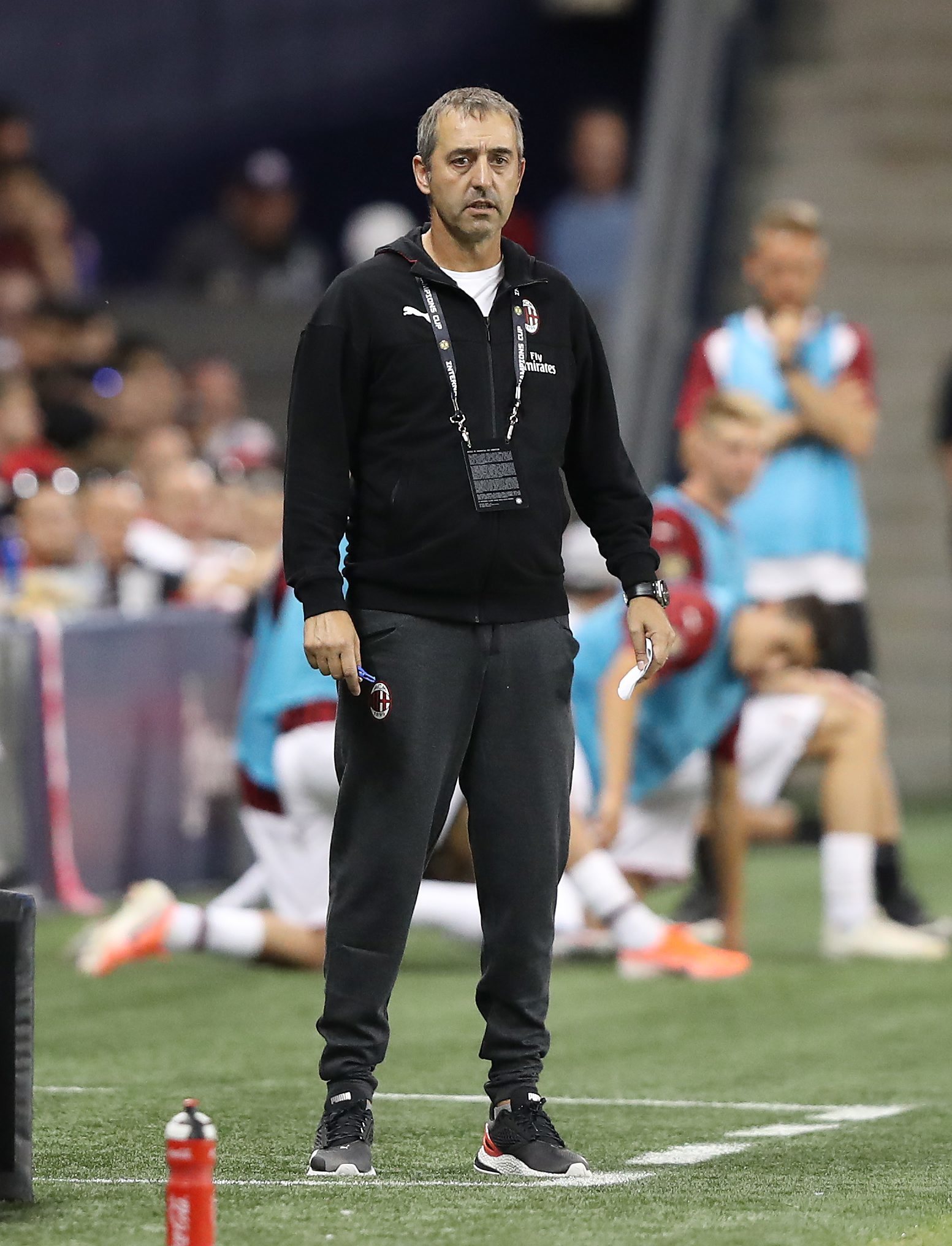“I believe in my ideas, but this Milan team looked like it turned up without ever having a training session together. It played badly on an individual level, with no organization or sense of collective responsibility”. Nothing gives a clearer impression of how poorly AC Milan's season has started than the words pronounced by their own coach, Marco Giampaolo, at the end of the match against Fiorentina. The three goals scored by the Viola at San Siro resulted in the fourth defeat in six games for the Rossoneri, surely not the landmark that their fans, who left the stadium on Sunday evening well before the final whistle, were expecting to reach after yet another new start. Milan hadn't lost four of the first six games since the 1938-39 season. And what's even more worrying is that the six points collected so far, are the result of wins, both for 1-0, against Brescia and Hellas Verona, two of the three teams just promoted from the Serie B. The Berlusconi era is now well over and in recent years, Milan's technical potential has been gradually depleted and not even the most sanguine of their supporters expected this team to compete for the Scudetto, but it was rather difficult to predict such an abysmal start. This summer the management selected by the Elliot fund (which includes club legends Paolo Maldini and Zvonimir Boban) has followed a transfer market strategy aimed at cutting wages (-€25 million compared to last season) and towards the purchasing of young players to be developed, such as 20-years-old striker Rafael Leao, which can allow the club to draw significant resources from player trading and therefore to pursue a sustainable growth model. The policy makes even more sense given that they've been excluded from the Europa League over breaches of Financial Fair Play rules. In theory then, a coach capable of nurturing talent, such Giampaolo, sould play a key role. All in all, the roster at Giampaolo's service is not very different from the one which Gennaro Gattuso led to fifth place last season. In addition to Leao, they purchased Léo Duarte (23 years old) as a backup for centerbacks Alessio Romagnoli and Mateo Musacchio, leftback Theo Hernández (21), Empoli’s midfielders Ismaël Bennacer (21) and Rade Krunic (25) and Ante Rebic (25), who arrived on loan in a double swap deal, with André Silva joining Eintracht Frankfurt on loan for two years. Although new purchases were not immediately included in the starting XI (their total playing time to date accounts for 14.9% of total minutes), so far Milan players have not been able to assimilate the ideas of the former coach of Sampdoria, whose employment status is now tenuous at best. Although Giampaolo has tried to propose tweaks to his favorite system of play, the 4-3-1-2, AC Milan’s play has been very poor both on offense and defense. The results are only the logical consequence of the team's performance.
Offensive struggles and tactical conundrums
At Giampaolo's debut on the Milan bench, the Rossoneri weren't able to fire a single shot on target against Udinese’s keeper Juan Musso and generated just 0.52 expected goals. Apart from a 2.32 xG outlier against Torino, which was the best Milan game of the season, they have struggled to create high-scoring opportunities (0.075 xG/shot on average, sixteenth in the league) and to convert them in other matches, too. No wonder their shot map looks like Pablo Picasso’s palette during his Blue Period. 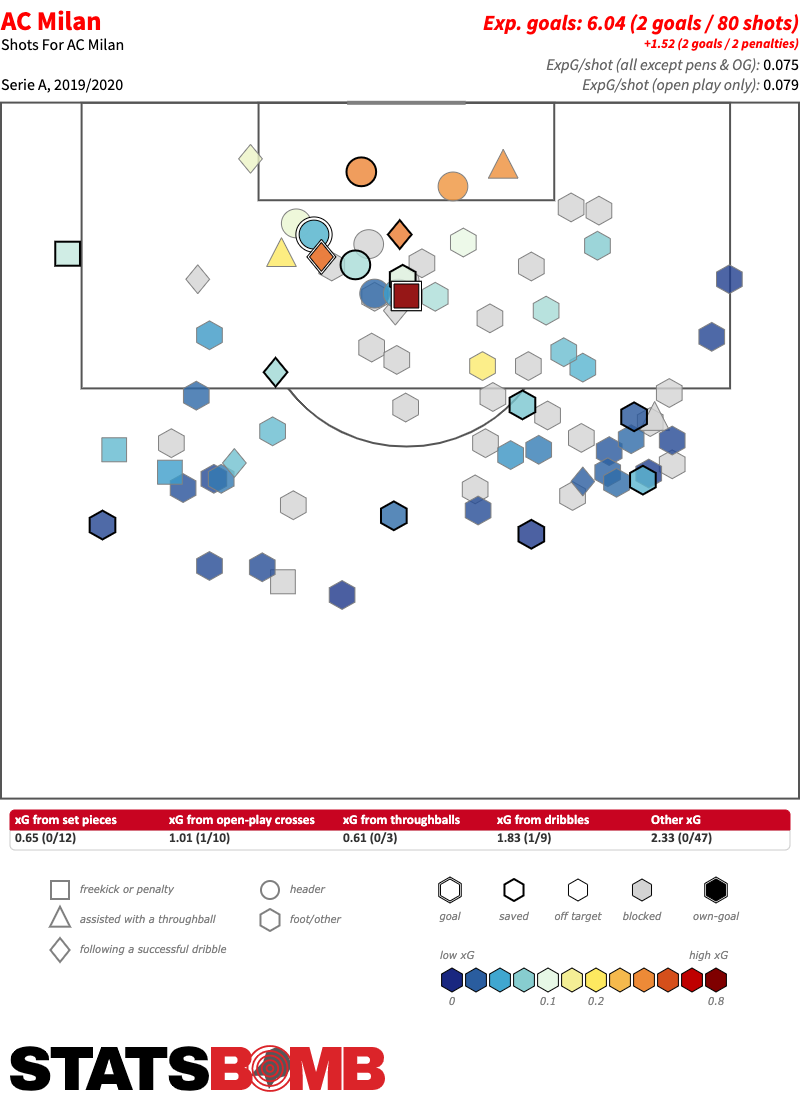 Not only have they generated just 1.00 xG on average (13th in the league), but they have not been able to convert their chances at a rate not even remotely acceptable, having scored only two open play goals, the worst figure in the entire Serie A. They are below league average in every main offensive stat, so of course their attacking radar looks ugly.
Not only have they generated just 1.00 xG on average (13th in the league), but they have not been able to convert their chances at a rate not even remotely acceptable, having scored only two open play goals, the worst figure in the entire Serie A. They are below league average in every main offensive stat, so of course their attacking radar looks ugly. 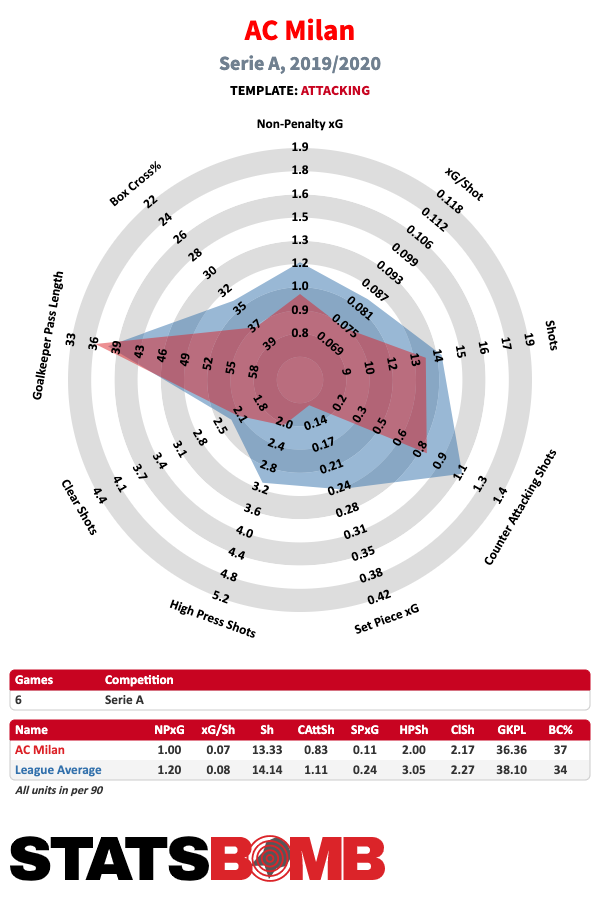 In a situation where the team has a hard time scoring, it's normal for the starting striker to become the target of criticism. Krzysztof Piątek is responsible for 35% of Milan's total xG (2.11 out of a total of 6.04 xG), but he's still on the hunt for his first open play goal. An xG overperformer in 2018-2019 (his scoring efficiency was ~146%), the average quality of his shots this season (0.111) is much lower than that of the 1459 minutes played with AC Milan jersey last season (0.152), but in line with that of his amazing period at Genoa (0.102), in which he scored at will but with a rate well beyond expectations.
In a situation where the team has a hard time scoring, it's normal for the starting striker to become the target of criticism. Krzysztof Piątek is responsible for 35% of Milan's total xG (2.11 out of a total of 6.04 xG), but he's still on the hunt for his first open play goal. An xG overperformer in 2018-2019 (his scoring efficiency was ~146%), the average quality of his shots this season (0.111) is much lower than that of the 1459 minutes played with AC Milan jersey last season (0.152), but in line with that of his amazing period at Genoa (0.102), in which he scored at will but with a rate well beyond expectations. 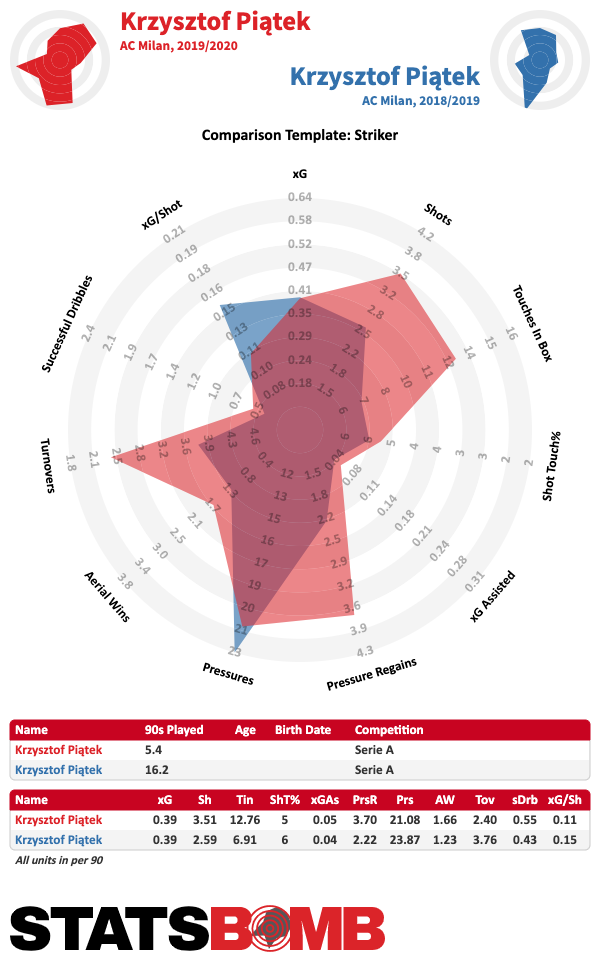 In general, if you look at his data, he's shooting more, touching twice as many balls in the box and losing the ball less than during his first six months with the Rossoneri. But are we sure that he will ever stand out as a lone striker in a system of play that doesn't capitalize on his strengths? Piatek is a poacher. His greatest ability is scoring goals. When he doesn't score, though, his limitations emerge more clearly. His overall contribution to team play is not consistent and even if he doesn't lose too many balls, he's not particularly effective with his back to the goal (his percentage of completed passes decreases by 12% when he is pressed) or at playing wall-passes, which are pivotal to ball progression in Giampaolo’s system. He doesn’t create scoring chances for his team-mates (0.05 open play xG assisted per 90 minutes this season, 0.04 last season) and not even for himself, given that he rarely manages to dribble his direct opponent (0.55 successful dribbles per 90 this season, 0.43 last season). Since Piatek can't be expected to create opportunities, it's the players around him who have to do it. In this sense, there were high expectations for Suso. Throughout the summer it was discussed whether the Spaniard could prove to be the right player to play as the trequartista in Giampaolo's 4-3-1-2. So far, the answer on the pitch seems to be negative, so much so that the Milan coach has given up deploying Suso in that role, choosing instead a 4-3-3 in the last few games. Suso plays 1.74 open-play key passes per 90, more than any teammate with at least 300 minutes played, but his contribution in terms of xG assisted is at 0.17 per 90. That's not really what you expect for your main creator. Moreover, his attacking danger is limited to the few chances he creates, since he generated only 0.09 xG per 90 from over two shots on average because of the highly questionable shooting selection that has characterized his career. Suso is a player who has a reluctance to use both feet and who tends to be predictable: he seemed lost away from the right flank and Giampaolo immediately had to move him back in his natural position. A bit like Piatek, he seems not very functional to the new football project and he has already become a walking tactical conundrum in Milanello. In theory, along with goalkeeper Gianluigi Donnarumma, the Spaniard was the most valuable asset on the roster and since at least on paper his compatibility with football ideas of the new coach (despite the statements of Giampaolo himself) was limited, he could have been sacrificed on the transfer market to finance the signings of different kind of players. But apparently it was his new manager’s decision to keep him, so now it is also his problem to solve. And it’s a problem that needs to be solved fast, considering that the team's midfield isn't exactly showing any signs of brilliance either. Milan’s offensive structure is often disconnected and there are limited options for progressive passes and a lack of players between the lines to receive the ball. Although there is almost no difference between the average number of carries of Hakan Calhanoglu and Franck Kessié and the midfielders of Sampdoria last season, the eye test tends to suggest that the two keep the ball too much (and indeed their carries are 13.5% longer on average) and distribute it with too much laziness, giving the opponents time to take sides on the pitch or, worse, to recover the ball, as happened on the occasion of two of the three goals for Fiorentina, both created by the Turkish player's turnovers. Below you can see the map of their open play passing combined and see how it is full of horizontal passes while also lacking penetration in central zones.
In general, if you look at his data, he's shooting more, touching twice as many balls in the box and losing the ball less than during his first six months with the Rossoneri. But are we sure that he will ever stand out as a lone striker in a system of play that doesn't capitalize on his strengths? Piatek is a poacher. His greatest ability is scoring goals. When he doesn't score, though, his limitations emerge more clearly. His overall contribution to team play is not consistent and even if he doesn't lose too many balls, he's not particularly effective with his back to the goal (his percentage of completed passes decreases by 12% when he is pressed) or at playing wall-passes, which are pivotal to ball progression in Giampaolo’s system. He doesn’t create scoring chances for his team-mates (0.05 open play xG assisted per 90 minutes this season, 0.04 last season) and not even for himself, given that he rarely manages to dribble his direct opponent (0.55 successful dribbles per 90 this season, 0.43 last season). Since Piatek can't be expected to create opportunities, it's the players around him who have to do it. In this sense, there were high expectations for Suso. Throughout the summer it was discussed whether the Spaniard could prove to be the right player to play as the trequartista in Giampaolo's 4-3-1-2. So far, the answer on the pitch seems to be negative, so much so that the Milan coach has given up deploying Suso in that role, choosing instead a 4-3-3 in the last few games. Suso plays 1.74 open-play key passes per 90, more than any teammate with at least 300 minutes played, but his contribution in terms of xG assisted is at 0.17 per 90. That's not really what you expect for your main creator. Moreover, his attacking danger is limited to the few chances he creates, since he generated only 0.09 xG per 90 from over two shots on average because of the highly questionable shooting selection that has characterized his career. Suso is a player who has a reluctance to use both feet and who tends to be predictable: he seemed lost away from the right flank and Giampaolo immediately had to move him back in his natural position. A bit like Piatek, he seems not very functional to the new football project and he has already become a walking tactical conundrum in Milanello. In theory, along with goalkeeper Gianluigi Donnarumma, the Spaniard was the most valuable asset on the roster and since at least on paper his compatibility with football ideas of the new coach (despite the statements of Giampaolo himself) was limited, he could have been sacrificed on the transfer market to finance the signings of different kind of players. But apparently it was his new manager’s decision to keep him, so now it is also his problem to solve. And it’s a problem that needs to be solved fast, considering that the team's midfield isn't exactly showing any signs of brilliance either. Milan’s offensive structure is often disconnected and there are limited options for progressive passes and a lack of players between the lines to receive the ball. Although there is almost no difference between the average number of carries of Hakan Calhanoglu and Franck Kessié and the midfielders of Sampdoria last season, the eye test tends to suggest that the two keep the ball too much (and indeed their carries are 13.5% longer on average) and distribute it with too much laziness, giving the opponents time to take sides on the pitch or, worse, to recover the ball, as happened on the occasion of two of the three goals for Fiorentina, both created by the Turkish player's turnovers. Below you can see the map of their open play passing combined and see how it is full of horizontal passes while also lacking penetration in central zones. 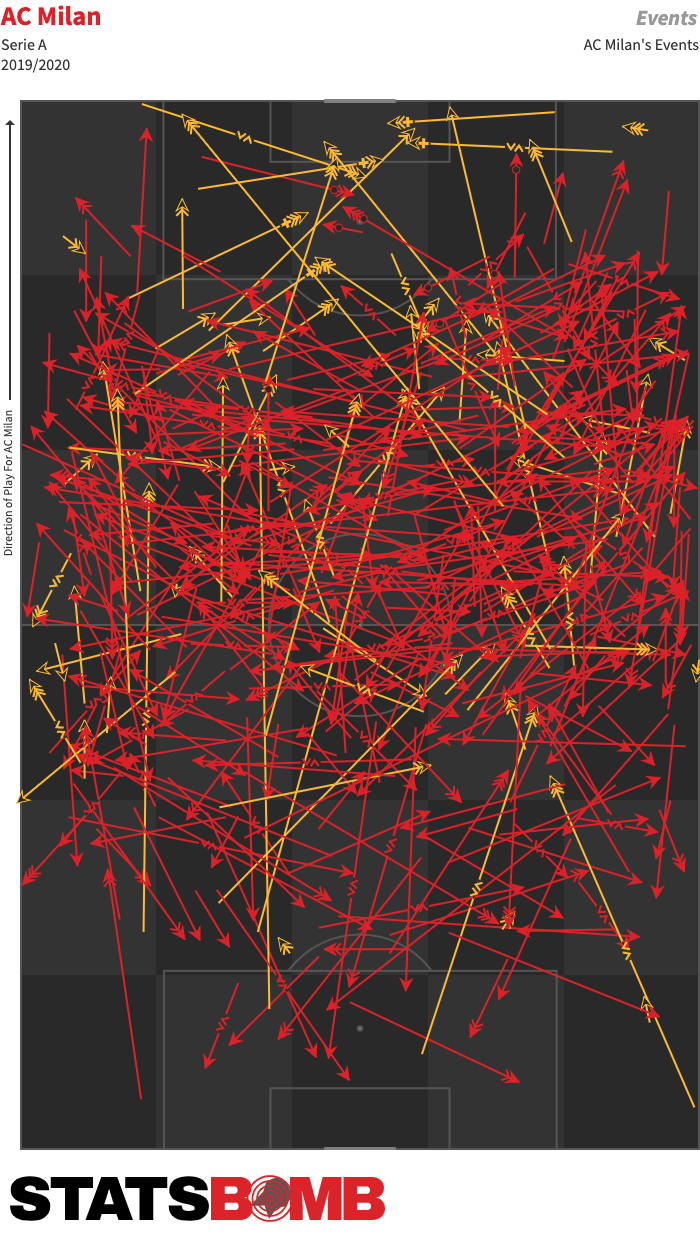 There aren’t many more alternatives in midfield and unless Giampaolo plays Lucas Paquetá, who could also be a good trequartista if the team went back to a 4-3-1-2, there is not much room to twist the line-up in these roles and we will likely see the same midfield in the coming games, too. Surely Ismael Bennacer, who seems to have now surpassed Lucas Biglia, AC Milan’s oldest player at 34, as the starting holding midfielder, seems to be able to bring more incisiveness to the passing game of Milan, although the match with Fiorentina was a disaster for him because of the two penalties he caused.
There aren’t many more alternatives in midfield and unless Giampaolo plays Lucas Paquetá, who could also be a good trequartista if the team went back to a 4-3-1-2, there is not much room to twist the line-up in these roles and we will likely see the same midfield in the coming games, too. Surely Ismael Bennacer, who seems to have now surpassed Lucas Biglia, AC Milan’s oldest player at 34, as the starting holding midfielder, seems to be able to bring more incisiveness to the passing game of Milan, although the match with Fiorentina was a disaster for him because of the two penalties he caused. 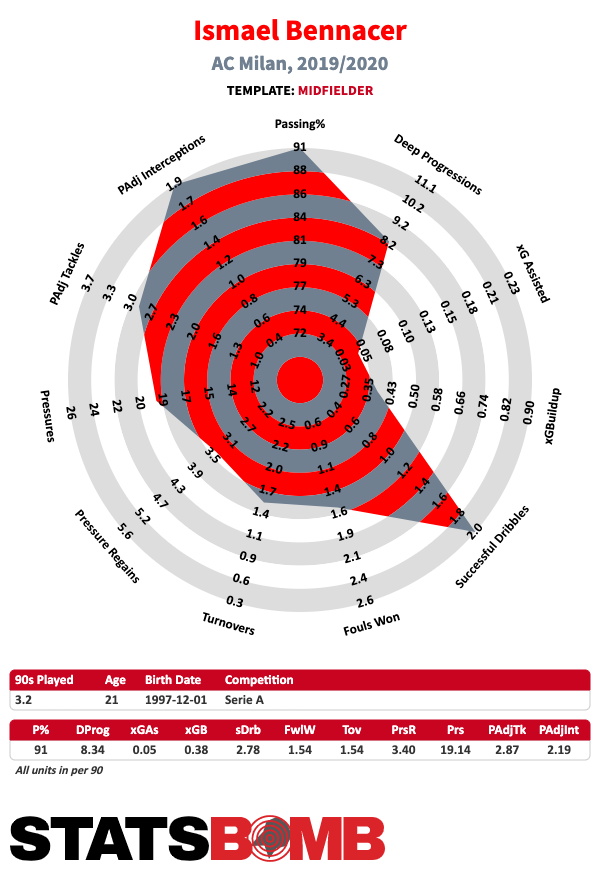 Speaking of new signings, Rafael Leao is definitely worthy of a starting spot and the Portuguese could be, at least in part, the solution to Milan's problems. So far the 20-year-old, who scored 0.53 non-penalty goals per 90 for Lille last season, has played mainly on the left wing, but he has the off-the-ball moves, the strength, and the smartness to play with his back to his goal to complement Piatek in a striking partnership or to play as the lone striker. In both cases, unless Suso significantly improves in a central offensive midfielder role, Giampaolo will have to make an important decision and probably put the Spaniard or Piatek on the bench. The Portuguese striker (2.67 dribbles and 2.00 key passes on average, in just 270 minutes) can give that offensive unpredictability that Milan damn well needs while the team adapts to the new brand of football. Focus on what Leao does before the goal here: shielding the ball with his back to the goal, passing it to a team-mate to gain territory and offering a passing option toward the inside of the pitch to the wide ball-carrier.
Speaking of new signings, Rafael Leao is definitely worthy of a starting spot and the Portuguese could be, at least in part, the solution to Milan's problems. So far the 20-year-old, who scored 0.53 non-penalty goals per 90 for Lille last season, has played mainly on the left wing, but he has the off-the-ball moves, the strength, and the smartness to play with his back to his goal to complement Piatek in a striking partnership or to play as the lone striker. In both cases, unless Suso significantly improves in a central offensive midfielder role, Giampaolo will have to make an important decision and probably put the Spaniard or Piatek on the bench. The Portuguese striker (2.67 dribbles and 2.00 key passes on average, in just 270 minutes) can give that offensive unpredictability that Milan damn well needs while the team adapts to the new brand of football. Focus on what Leao does before the goal here: shielding the ball with his back to the goal, passing it to a team-mate to gain territory and offering a passing option toward the inside of the pitch to the wide ball-carrier. 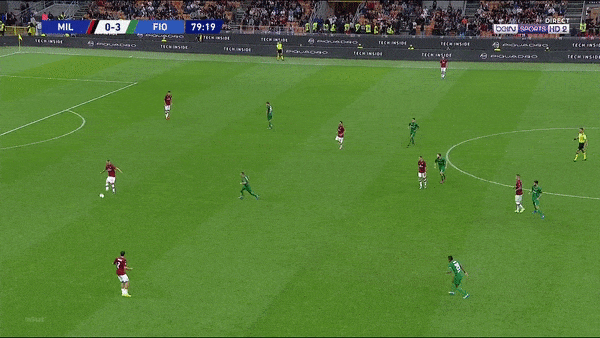 The same goes for left-winger Ante Rebic, who has so far played just 82 minutes overall and could find more space in a different configuration. The Croatian is a player who takes risks, which is something that for now his teammates don't do, knows how to overtake his direct opponent and is also able to offer a good scoring contribution for a wide player. The under fire ex-Sampdoria manager has to earn himself time and Leao and Rebic could give it to him.
The same goes for left-winger Ante Rebic, who has so far played just 82 minutes overall and could find more space in a different configuration. The Croatian is a player who takes risks, which is something that for now his teammates don't do, knows how to overtake his direct opponent and is also able to offer a good scoring contribution for a wide player. The under fire ex-Sampdoria manager has to earn himself time and Leao and Rebic could give it to him.
When pressing fails, the defense collapses
In the first three games, the defense had been the main strength of Milan: conceding a single goal, the Rossoneri had managed to earn 6 points out of 9 despite their offensive woes. But it is also true that Udinese (18th for non-penalty xG), Brescia (17th) and Hellas Verona (13th) are among the worst teams in Serie A in terms of offensive production. It was therefore predictable that Milan would suffer more against stronger opponents. In the following three games against Inter, Torino and Fiorentina, Milan suffered 6 open play goals, conceding way more opportunities to their opponents. But, if Giampaolo was expected to make the Rossoneri defend higher up the pitch, you can’t be particularly disappointed. Milan is third in defensive distance and fourth in passes per defensive action (PPDA), two indexes of a team that brings relatively high and aggressive pressure. Among other positive notes, they are the team with the second most counterpressure actions (232) and they also conceded the least deep completions in the league (just two on average). 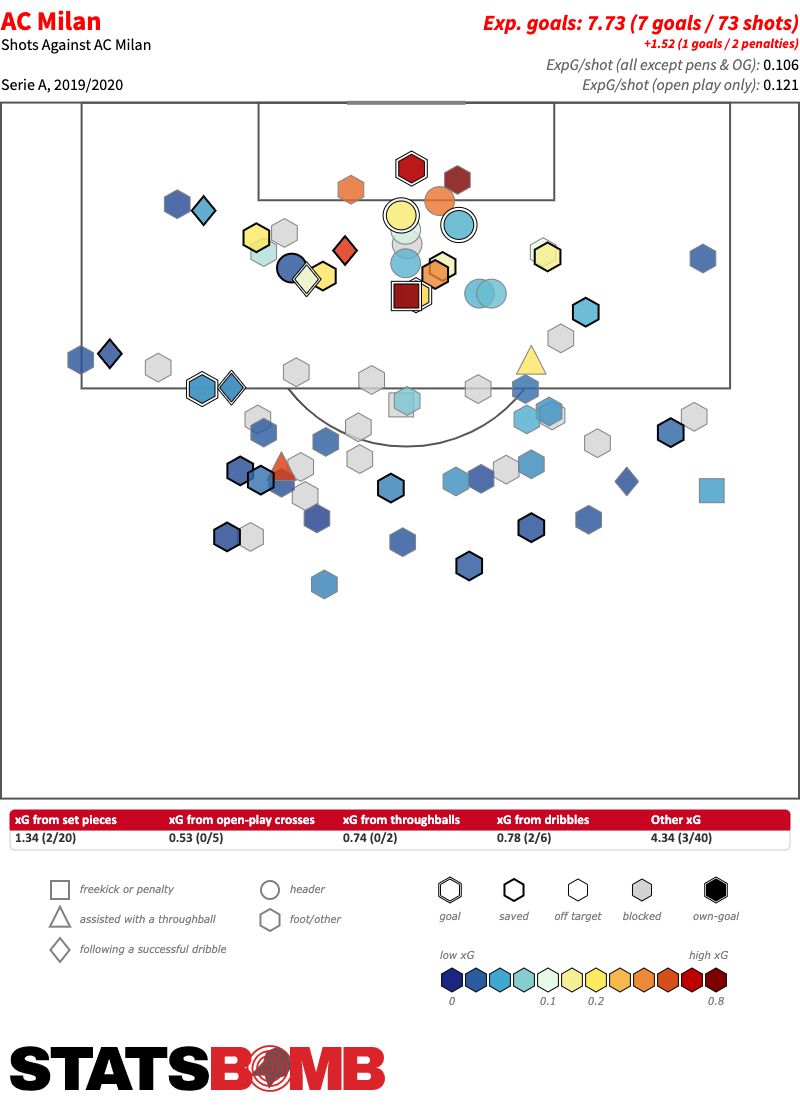 The main defensive problem is the high average value of opponents' chances. AC Milan concedes open-play shots with an average xG of 0.12, a sign that when the pressing fails (and we saw it well in games against Torino, Inter and Fiorentina) there are too many spaces in which to build high-scoring opportunities. Pressing requires well-oiled mechanisms that develop over time, but when those processes fail, Milan is far too vulnerable and there is too much space to cover for defensive players. That situation puts a strain on the center backs, who are often forced to face their opponents one on one in critical situations. Romagnoli, who last year was the best defender in the league in percentage of tackles compared to times dribbled pass (87%), is now dribbled 44% of the time that he attempts a tackle, while the percentage rises to 56% for the other defender Musacchio. You don't become a pressing defensive force in a month, but again since they aren't scoring, there's no cushion compensate for those goals conceded due to growing pains.
The main defensive problem is the high average value of opponents' chances. AC Milan concedes open-play shots with an average xG of 0.12, a sign that when the pressing fails (and we saw it well in games against Torino, Inter and Fiorentina) there are too many spaces in which to build high-scoring opportunities. Pressing requires well-oiled mechanisms that develop over time, but when those processes fail, Milan is far too vulnerable and there is too much space to cover for defensive players. That situation puts a strain on the center backs, who are often forced to face their opponents one on one in critical situations. Romagnoli, who last year was the best defender in the league in percentage of tackles compared to times dribbled pass (87%), is now dribbled 44% of the time that he attempts a tackle, while the percentage rises to 56% for the other defender Musacchio. You don't become a pressing defensive force in a month, but again since they aren't scoring, there's no cushion compensate for those goals conceded due to growing pains.
Conclusion
It seems absurd after only six games, but the new Milan project is already hanging by a thread. Changing the sixth coach in five years now would probably be a mistake, since at least in the first half against Torino we saw what the team is capable of, but this group is still too far behind and the problems are not just about learning the new system. It's time for Giampaolo to take important choices before the management takes them about his future.
